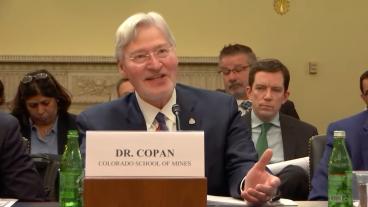.jpg) A team of Colorado School of Mines researchers has been awarded a three-year U.S. Department of Energy grant to develop a method for transforming solar and wind power into a highly transportable, carbon-neutral liquid fuel.
A team of Colorado School of Mines researchers has been awarded a three-year U.S. Department of Energy grant to develop a method for transforming solar and wind power into a highly transportable, carbon-neutral liquid fuel.
Neal Sullivan, associate professor of mechanical engineering and director of the Colorado Fuel Cell Center, is the lead primary investigator on the project, the recipient of $3 million in funding from the Advanced Research Projects Agency-Energy (ARPA-E).
Three other Mines faculty members—Ryan O’Hayre, professor of metallurgical and materials engineering; Jason Ganley, assistant department head and teaching associate professor in chemical and biological engineering; and Robert Kee, George R. Brown Distinguished Professor in Mechanical Engineering—are co-PIs. FuelCell Energy of Danbury, Connecticut, is also a partner.
The project tackles one of the biggest challenges facing solar and wind power as its market penetration continues to grow—its intermittency.
“A cloud comes and you’ve got no solar power. This country will not tolerate that,” Sullivan said. “Our way of solving that issue right now is by putting it back on the central provider of electricity, the big power plant. The big power plant has to have all this reserve electricity-generating capacity so when a cloud comes over the sun, we don’t have brownouts. That somewhat defeats the purpose of using solar and wind power. The point was to reduce the use of these central electric generators.”
“The objective is try to flatten out that intermittency in the electricity supply,” Sullivan said. “Our approach to doing that is harnessing this electricity from solar and wind and putting it into another form of energy.”
The form they’ve chosen is chemical energy, or, more specifically, ammonia, an easily transportable liquid fuel that has a high energy density and does not emit greenhouse gases when burned.
To do that, the team is developing a protonic-ceramic electrolyzer—essentially a fuel cell or flow battery working in reverse—that generates ammonia (NH3) from nitrogen and water to enable near-lossless storage of wind and solar electricity. Mines and the Colorado Fuel Cell Center are leaders in the field of proton-conducting ceramics.
Nitrogen, water vapor and renewable electricity will go into the electrolyzer, with oxygen and ammonia coming out.
“There are those that feel that ammonia is the answer to our energy issues,” Sullivan said. “It doesn’t emit any greenhouse gases. It takes a liquid form, which makes it easy to transport around. And there’s a lot of bang for your buck—it’s got a high energy density. That’s a pretty good way to store energy in chemical form.”
The DOE funding will also be used to support undergraduate and graduate students in mechanical engineering and materials science.
CONTACT
Emilie Rusch, Public Information Specialist, Communications and Marketing | 303-273-3361 | erusch@mines.edu
Mark Ramirez, Managing Editor, Communications and Marketing | 303-273-3088 | ramirez@mines.edu




